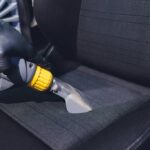Cigarette smoke smell in a car is notoriously persistent. Whether you’ve recently quit smoking, purchased a pre-owned vehicle, or inherited a car from a smoker, that lingering odor can be frustrating and unpleasant. At cars.edu.vn, we understand how important a fresh and clean car interior is. That’s why we’ve created this comprehensive guide to help you effectively eliminate cigarette smoke smell from your car, restoring its freshness and making your drives more enjoyable.
I. Initial Steps for Smoke Smell Removal
Before diving into specific techniques, it’s crucial to lay the groundwork with some essential preliminary steps. These actions target the surface-level sources of the odor and prepare your car for deeper cleaning methods.
A. Ensure Proper Ventilation
Begin by opening all car windows and, if possible, park your car in a well-ventilated area or outdoors. This simple step is crucial as it allows for natural air circulation, helping to initially dissipate some of the smoke smell and ventilate cleaning fumes later on.
B. Remove Obvious Sources of Odor
Thoroughly inspect your car for any visible remnants of smoking. This includes:
- Ashtrays: Empty and clean ashtrays meticulously. Even if seemingly empty, they can harbor lingering ash and odor.
- Cigarette Butts and Packaging: Remove any cigarette butts, empty packs, or related litter from the car, including under seats and in door pockets.
- Trash and Debris: Clear out any general trash, as smoke odors can cling to other materials in the car.
C. Deep Clean Your Car’s Interior
A comprehensive interior cleaning is paramount. Focus on all surfaces, as smoke particles permeate throughout the car.
-
Vacuum Thoroughly: Use a powerful vacuum cleaner with attachments to vacuum every area of your car’s interior. Pay special attention to:
- Carpets and Floor Mats: These fabrics readily absorb smoke. Remove floor mats and vacuum them separately on both sides.
- Upholstery: Vacuum car seats and any fabric upholstery meticulously, using crevice tools to reach seams and tight spots.
- Nooks and Crannies: Vacuum along dashboards, consoles, air vents, and any other crevices where smoke particles can accumulate.
-
Steam Clean Fabrics (Optional but Recommended): For a deeper clean, use a steam cleaner on fabric upholstery and carpets. Steam cleaning helps to lift embedded smoke particles and odors. If you remove seat covers and floor mats, consider steam cleaning them separately for even better results.
-
Wipe Down Hard Surfaces: Use appropriate cleaners for different interior surfaces:
- Leather: Clean leather surfaces (seats, steering wheel, trim) with a dedicated leather cleaner and conditioner, following product-specific instructions.
- Vinyl and Plastic: Wipe down the dashboard, door panels, consoles, and other plastic or vinyl surfaces with an all-purpose cleaner or a solution of mild soap and water. White vinegar diluted with water (half and half) can also be effective and is a natural deodorizer.
- Glass: Clean interior windows and mirrors with a glass cleaner like Windex. Tar and nicotine from cigarette smoke often create a film on glass surfaces, so thorough cleaning is essential.
-
Consider Upholstery and Carpet Replacement (Severe Cases): If the smoke smell is extremely strong and deeply ingrained, particularly in older cars with heavily smoked-in interiors, you might consider replacing upholstery, headliners, carpets, and floor mats for a truly fresh start.
D. Address the Ventilation System
The car’s ventilation system can trap and recirculate smoke odors. It’s important to clean both the air conditioning and heating systems.
-
Air Out the Duct System:
- Start your car engine and set it to park.
- Turn the air conditioning to its maximum cool setting (lowest temperature, highest fan speed).
- Ensure the air recirculation is turned OFF to draw in fresh outside air.
- Roll down all windows and let the AC run for 10-15 minutes to help blow out trapped smoke odors.
-
Neutralize the Air Intake:
- While the AC is still running at maximum, locate the car’s air intake vent. This is often found under the hood, near the base of the windshield, or sometimes on the passenger side fender. Consult your car’s manual if you’re unsure of its location.
- Spray an odor neutralizer (like Ozium or a similar product designed for air vents) directly into the air intake vent. This will help neutralize odors as air is drawn into the system. Continue spraying intermittently until you notice a reduction in the smoke smell emanating from the vents.
-
Neutralize the Heating System:
- Repeat the process for the heating system. Turn the heat to its maximum setting (highest temperature, highest fan speed).
- Again, with windows down, spray odor neutralizer into the air intake vent while the heat is running. This addresses smoke odors trapped within the heating ducts.
II. Effective Home Remedies for Cigarette Odor Removal
After the initial cleaning, you can utilize several common household items known for their odor-absorbing properties. These home remedies are often effective for milder smoke smells or as follow-up treatments.
A. White Vinegar: A Natural Odor Absorber
White vinegar is a powerful natural odor neutralizer.
- Method: Pour white vinegar into a bowl or cup (undiluted). Place the bowl inside your car overnight with windows closed. The vinegar will absorb odors from the air. You can also leave multiple bowls for larger vehicles or stronger smells. The vinegar smell will dissipate as it dries, taking the smoke odor with it.
B. Baking Soda: The Versatile Deodorizer
Baking soda is renowned for its odor-absorbing capabilities.
- Method 1 (Sprinkling): Sprinkle baking soda liberally on car carpets and floor mats. Let it sit for several hours, or ideally overnight, to absorb odors. Vacuum up the baking soda thoroughly.
- Method 2 (Open Box): Place an open box or dish of baking soda in your car. Leave it for a few days to continuously absorb odors. Replace the baking soda every few days for optimal effectiveness, especially in persistent cases.
C. Activated Charcoal: Powerful Odor Elimination
Activated charcoal is highly porous and effective at trapping odor molecules.
- Method: Place bowls or bags of activated charcoal inside your car. Leave them for a few days to absorb cigarette smoke odor. You can purchase activated charcoal in various forms, including granules or bags specifically designed for odor absorption.
D. Citrus Peels: A Natural Air Freshener and Deodorizer
Citrus fruits offer a natural and pleasant way to combat smoke smell.
- Method: Place peels from fresh lemons, limes, or oranges in a bowl inside your car. The citrus oils help to neutralize odors and leave a fresh, clean scent. Replace the peels every couple of days as they dry out.
E. Coffee Grounds: Masking and Absorbing Odors
Dry coffee grounds can help absorb odors, although they are more likely to mask rather than eliminate the smoke smell completely.
- Method: Place bowls of dry coffee grounds in your car. Leave them for a day or two. The coffee aroma can temporarily overpower the smoke smell.
F. Dryer Sheets: Quick Deodorizing for Fabrics
Dryer sheets can provide a quick freshening effect, especially on fabric surfaces.
- Method: Wipe down cloth car seats and upholstery with dryer sheets. This can impart a pleasant scent and help to deodorize surfaces. However, dryer sheets are primarily a masking solution and won’t address the root cause of the odor.
G. Cat Litter (Unscented): Surprisingly Effective Absorbent
Unscented cat litter, particularly clay-based litter, is designed to absorb odors and moisture.
- Method: Place a bowl or container of unscented cat litter in your car. Leave it for a couple of days to absorb cigarette smoke odors. Ensure it’s unscented to avoid adding another competing smell.
III. Professional-Grade Solutions for Stubborn Smoke Smell
For deeply embedded or persistent cigarette smoke odors, professional-grade products and treatments offer more powerful solutions. These methods are designed to eliminate odors at a molecular level rather than simply masking them.
A. Ozium: A Highly Effective Air Sanitizer
Ozium is an air sanitizer that is more potent than typical air fresheners like Febreze. It’s designed to neutralize and eliminate odors, including cigarette smoke, as well as disinfect against airborne bacteria.
- Method: Spray Ozium lightly throughout the car’s interior. It’s often recommended to do this overnight, leaving the windows closed to allow the product to work effectively. Repeat the application as needed until the smoke smell is gone. Follow product instructions carefully and ensure adequate ventilation after use.
B. Odor Bombs (Car Deodorizers): Deep Odor Elimination
“Odor bombs,” also known as car deodorizer foggers, are aerosol products that release a deodorizing fog throughout the car’s interior, penetrating into vents and fabrics to eliminate odors.
- Method: Follow the specific instructions on the odor bomb product. Typically, you’ll activate the fogger, place it in the center of the car, close all doors and windows, and let it release its fog for a specified time (usually 10-15 minutes). Afterward, thoroughly ventilate the car by opening all doors and windows for an extended period to remove any product residue and lingering scent. Odor bombs are designed to destroy odors at their source, not just cover them up.
C. Ozone Treatment: The Ultimate Odor Removal Solution
Ozone treatment, also known as ozone shock treatment, is the most powerful method for removing cigarette smoke smell and other stubborn odors. Ozone (O3) is a highly reactive form of oxygen that breaks down odor molecules at a molecular level.
-
Professional Treatment Recommended: While you can rent ozone generators, professional ozone treatment is highly recommended due to safety precautions and ensuring effective application. Ozone in high concentrations can be harmful to humans and pets.
-
How it Works: An ozone generator produces ozone gas, which is circulated within the closed car. The ozone molecules react with and neutralize odor molecules, including those from cigarette smoke. After treatment, the ozone dissipates, leaving behind fresh, clean air.
-
Steps (If Using an Ozone Generator Yourself – with Caution):
- Thorough Cleaning: First, perform a thorough interior cleaning as described in Section I, as ozone works best when surface sources of odor are minimized.
- Generator Placement: Place the ozone generator inside the car or connect it via a hose, following the generator’s instructions.
- Ozone Generation: Run the ozone generator for the recommended time, typically 30 minutes to a few hours, depending on the severity of the odor and generator strength. Ensure no people or pets are in the car during treatment.
- Circulation: Turn on the car’s fan (through the AC system, with recirculation off) to help circulate ozone through the ventilation ducts during treatment.
- Ventilation After Treatment: After ozone treatment is complete, thoroughly air out the car for a significant period (at least 1-2 hours, or preferably overnight) by opening all doors and windows. Drive with windows down to ensure all residual ozone dissipates before regular use.
-
Important Note on Ozone Safety: Ozone can be harmful if inhaled in high concentrations. Always follow safety guidelines provided with ozone generators and prioritize professional treatment for safety and effectiveness. The EPA has noted that while ozone can be effective in unoccupied spaces for odor removal, it’s crucial to follow safety protocols and ventilate thoroughly afterward.
Conclusion
Removing cigarette smell from your car requires a multi-faceted approach, starting with thorough cleaning and progressing to targeted odor elimination techniques. By following these steps, from basic home remedies to professional-grade solutions like ozone treatment, you can effectively eliminate even stubborn cigarette smoke odors, restoring a fresh and clean environment to your vehicle and enhancing your driving experience. If you find the smell particularly persistent, don’t hesitate to seek professional car detailing services for specialized odor removal treatments.

